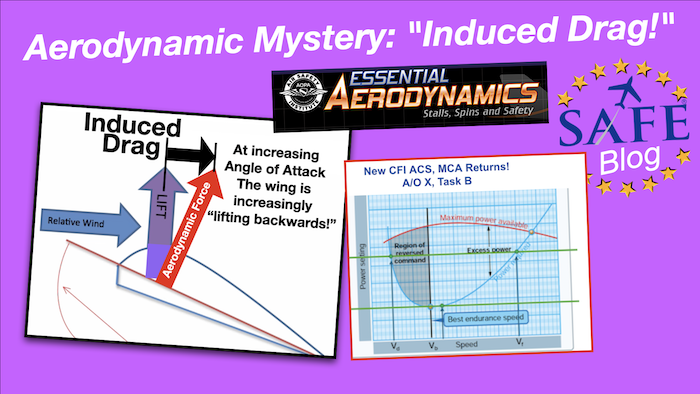 One of my first challenges as a new CFI was transitioning a retiring Air Force General, with massive fighter jet experience, into GA aircraft – guess who learned more? Not only did this General possess a refreshing lack of ego but this individual also continually emphasized an operational knowledge for pilots he called “fighter pilot math!” As pilots, we have a job to do in a busy environment with limited time and computing power (fortunately not at Mach 1.5). We are not Ph.D.s solving equations with Greek letters – nor should we be. We are optimizers in the heat of battle who need to get the job done in the most efficient manner given the circumstances; fly the plane!
One of my first challenges as a new CFI was transitioning a retiring Air Force General, with massive fighter jet experience, into GA aircraft – guess who learned more? Not only did this General possess a refreshing lack of ego but this individual also continually emphasized an operational knowledge for pilots he called “fighter pilot math!” As pilots, we have a job to do in a busy environment with limited time and computing power (fortunately not at Mach 1.5). We are not Ph.D.s solving equations with Greek letters – nor should we be. We are optimizers in the heat of battle who need to get the job done in the most efficient manner given the circumstances; fly the plane!

To that end, throughout my career teaching, I have also worked to provide practical-level explanations for pilots, not levels of complexity they will never master. I continually discover that most pilots fly very confidently, but are often confused about the most basic aerodynamics. Misunderstanding the difference between a slip and a skid, or maintaining that “any cross-controlled flight controlled force is dangerous” can seriously affect your flying (and safety). We try to explain and correct these misconceptions in our SAFE Webinars but when  we post these on YouTube, the comments often reveal serious misunderstandings and occasionally outright hostility. People aren’t only ignorant of the facts, they are also profoundly over-confident; they scream defiantly they are right (alas social media!) I think it is essential to stay humble and remember that what is often most dangerous in flying is “not what you don’t know but what you know (confidently) that ain’t so!” The AOPA course “Essential Aerodynamics has been rewritten and is a good primer for pilots. This is an operational-level explanation of the most basic principles.
we post these on YouTube, the comments often reveal serious misunderstandings and occasionally outright hostility. People aren’t only ignorant of the facts, they are also profoundly over-confident; they scream defiantly they are right (alas social media!) I think it is essential to stay humble and remember that what is often most dangerous in flying is “not what you don’t know but what you know (confidently) that ain’t so!” The AOPA course “Essential Aerodynamics has been rewritten and is a good primer for pilots. This is an operational-level explanation of the most basic principles.
In my defense, as another dumb pilot, I continually solicit advice and knowledge from all my highly-intelligent academic friends – in as much detail as I can comprehend or reasonably use to help others. This follows the same primary initial rule that doctors are taught in the Hippocratic Oath (from Hippocrates not hypocrite 🤣): “First do no harm” (Latin: Primum non nocere). I also try avoid being the (public) fool – always in the crosshairs.
To that end Dr,. (and Gold Seal CFI) Juan Merkt will be the primary speaker for our webinar on January 19th on Minimum Controllable Airspeed and the “new” MCA Maneuver in the CFI ACS. I will be the dummy asking the questions. Juan helped author the new Chapter Four in the Airplane Flying Handbook (so he too has already been the target of opinionated professionals). Register here for the webinar and we will all learn together. To Juan’s credit this will be a Top Down View” from the practical viewpoint of pilot operation rather than derived from equations and Greek letters.
“new” MCA Maneuver in the CFI ACS. I will be the dummy asking the questions. Juan helped author the new Chapter Four in the Airplane Flying Handbook (so he too has already been the target of opinionated professionals). Register here for the webinar and we will all learn together. To Juan’s credit this will be a Top Down View” from the practical viewpoint of pilot operation rather than derived from equations and Greek letters.
That Mysterious “Induced Drag!”
 So here is a simple-minded version of one thing most pilots don’t understand or never really even got concerned about; induced drag! There was an article in GA New recently on the same subject. First, the almost instinctual knowledge every adult comes to flying with is that adding power to a large mechanical device (boat, car, motorcycle) makes more speed. That seems axiomatic in our terrestrial world but is wrong in flying. When you get slower than best glide, it takes more power to fly *slower!* (Region of Reversed Command).
So here is a simple-minded version of one thing most pilots don’t understand or never really even got concerned about; induced drag! There was an article in GA New recently on the same subject. First, the almost instinctual knowledge every adult comes to flying with is that adding power to a large mechanical device (boat, car, motorcycle) makes more speed. That seems axiomatic in our terrestrial world but is wrong in flying. When you get slower than best glide, it takes more power to fly *slower!* (Region of Reversed Command).
![]()
Misunderstanding this can be fatal in critical situations like low and slow on the final approach or during a botched go- around with the excessive pitch-up most planes with approach trim go to (with full power “energizing” the elevator). So it is critical to understand, that even with full power, the only way to make airspeed here is to pitch down.
around with the excessive pitch-up most planes with approach trim go to (with full power “energizing” the elevator). So it is critical to understand, that even with full power, the only way to make airspeed here is to pitch down.
This is one reason I was taught the Navy method (1990 – actual Navy pilot) and originally taught this as a CFI; “pitch for airspeed.” In critical phases of flight, it will save your bacon. But it fails miserably when training a level-off to cruise from a climb.  The “Navy-method” pilot will reduce power immediately upon reaching altitude (power for altitude). Then you will be accelerating for the next 15 minutes at reduced power to reach a reasonable cruise speed. An integrated energy understanding would execute this maneuver as “energy transfer;” lowering the nose using power to first accelerate. Reading this article might help transform a dogmatic “Air Force” (power for airspeed) or “Navy” (pitch for airspeed) pilot toward a more integrated energy viewpoint (and smoother/safer flying).
The “Navy-method” pilot will reduce power immediately upon reaching altitude (power for altitude). Then you will be accelerating for the next 15 minutes at reduced power to reach a reasonable cruise speed. An integrated energy understanding would execute this maneuver as “energy transfer;” lowering the nose using power to first accelerate. Reading this article might help transform a dogmatic “Air Force” (power for airspeed) or “Navy” (pitch for airspeed) pilot toward a more integrated energy viewpoint (and smoother/safer flying).

Regarding that article in GA News recently; “lift” in most “aerodynamic speak” is not a force but a resultant vector defined as “90° to the relative wind.” So in the picture above, the purple vector is lift, the red arrow is “aerodynamic force” and the black arrow is induced drag. As the angle of  attack gets more extreme (presume our MCA maneuver at one G) the wing is actually “lifting backward!” The prop is providing some of the vertical force – “lift” (now the aerodynamics guys hate me) – holding up the plane. Pilots often call this “hanging on the prop” (which probably does not translate into Greek letters or sophisticated aerodynamics). Juan will take all the heat for this on Jan 19th🤣 Fly safely out there (and often)
attack gets more extreme (presume our MCA maneuver at one G) the wing is actually “lifting backward!” The prop is providing some of the vertical force – “lift” (now the aerodynamics guys hate me) – holding up the plane. Pilots often call this “hanging on the prop” (which probably does not translate into Greek letters or sophisticated aerodynamics). Juan will take all the heat for this on Jan 19th🤣 Fly safely out there (and often)
 Join us for a free webinar on flight control usage, “energy errors, and the new CFI ACS MCA maneuver in our January Webinar with (CFI/PhD) Juan Merkt. 90% of pattern stalls occur on take-off and turn-out (high power and high AOA/pitch attitude). Training at MCA creates an intuitive correct use of the rudder (and an awareness of “the feathered edge”). LOC-I is the #1 causal factor of fatal aviation accidents. MCA is precisely what pilots need to practice to fly safer (out of the “comfort zone!”)
Join us for a free webinar on flight control usage, “energy errors, and the new CFI ACS MCA maneuver in our January Webinar with (CFI/PhD) Juan Merkt. 90% of pattern stalls occur on take-off and turn-out (high power and high AOA/pitch attitude). Training at MCA creates an intuitive correct use of the rudder (and an awareness of “the feathered edge”). LOC-I is the #1 causal factor of fatal aviation accidents. MCA is precisely what pilots need to practice to fly safer (out of the “comfort zone!”)






